Your chickens will need properly formulated chicken feed that is the correct type for their age, for growth, sustenance and to produce eggs if they are hens of egg laying age. There are many old wives tales and alternative views on feeding, some say it’s marketing that has created all of these feeds and hens will survive well on wheat and others will say their grandad never had layers pellets and just fed his hens kitchen scraps! Formulated poultry feeds didn’t exist until recently, primarily created thanks to commercial research on hens diets as we tried to squeeze more and more eggs out of hens.
In days gone by though when ‘grandad fed scraps’, pure breeds were kept for eggs and they were fed grain mixes or dried mash chicken feed that had meat or fish meal added to increase the protein content. Hens would free range over a large area and could also supplement their diet with what they could forage. Bugs, insects and worms are all valuable sources of protein, not forgetting a good selection of greens providing vitamins and minerals.
“Grandad’s chickens didn’t get chicken feed and survived on kitchen scraps but they could free range to top up their diet on protein, vitamins, minerals and calcium from the fields or orchards they grazed. They didn’t produce anything like the number of eggs modern hybrid hens or some pure breeds produce.”
So in short, if you don’t feed a proper formulated layers feed to your hens, they won’t be able to keep up the demands that egg-laying puts on their bodies.
Layers Feeds and Protein
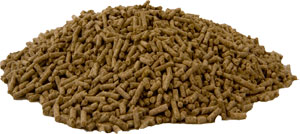 Chickens require protein to produce feathers and eggs as well as to grow. The amount of protein in their diet is important and you will see on the ingredients on the back of bags of commercial feeds the percentage of protein that they contain. It is higher in ‘Growers Pellets’ for example to enable chickens to grow and produce feathers. You will find that chickens stop laying eggs when they moult (lose their feathers and regrow new) as they are diverting protein from egg production to feather production. During the moult, you can scatter a handful of cat kibble in the run which helps them to top up with protein. Do not use dog food as most of the protein is derived from cereals.
Chickens require protein to produce feathers and eggs as well as to grow. The amount of protein in their diet is important and you will see on the ingredients on the back of bags of commercial feeds the percentage of protein that they contain. It is higher in ‘Growers Pellets’ for example to enable chickens to grow and produce feathers. You will find that chickens stop laying eggs when they moult (lose their feathers and regrow new) as they are diverting protein from egg production to feather production. During the moult, you can scatter a handful of cat kibble in the run which helps them to top up with protein. Do not use dog food as most of the protein is derived from cereals.
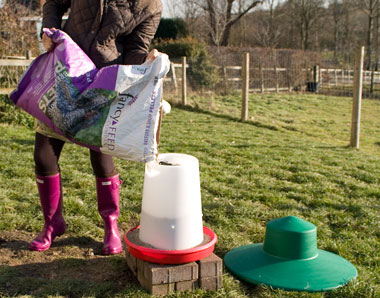
Commercial feeds contain the right balance of nutrients & can be fed ad-lib in hoppers if kept dry. This one has a rain hat.
Commercial chicken feeds have been well researched and contain the correct balance of minerals and nutriets required by chickens as well as sufficient protein and calcium which is essential for egg shell production. Layers pellets for example are around 16% protein. Wheat is about 10% protein and lacks essential vitamins that are required by chickens.
Formulated feeds come as pellets or mash and should be fed ad-lib so hens can take what they want as they need it. This type of feed must be kept dry or it will soon spoil. The feeder and rain hat shown above is the only sort I have found that really does keep the feed dry. Most have a hole in the top of the hat for a handle or for hanging and this lets water in. A feeder and rain hat similar to this one can be bought from Omlet.
Eggs are made up of around 80% protein so if there’s a shortage of protein in their diet, egg laying will be the first thing they your girls cut back on!
There is more information on the poultykeeper.com site which has a very good page of feeding chickens and chicken feed.
Mixed corn
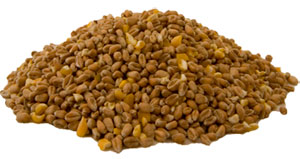 Mixed corn is usually 80 to 90% wheat and 10 to 20% maize. It is useful as a scratch feed, it keeps hens active, scratching around looking for it but should only be considered a treat. A handful per hen thrown late afternoon helps them to have a full crop overnight.
Mixed corn is usually 80 to 90% wheat and 10 to 20% maize. It is useful as a scratch feed, it keeps hens active, scratching around looking for it but should only be considered a treat. A handful per hen thrown late afternoon helps them to have a full crop overnight.
The maize (yellow in colour) is very fattening but can be useful during very cold weather to help your hens keep warm – I increase my girls’ ration of corn when it is cold over the winter, after they have finished moulting (they need lots of protein during the moult) since they are not laying eggs and need a little extra fat to burn in order to keep warm.
If you feed too much corn, your hens will get fat and fat hens don’t lay eggs!
Household scraps
Feeding household scraps is no longer allowed according toi DEFRA and can be a bit hit and miss anyway. You don’t really know what a hen is getting and the diet is very unbalanced. It is for this reason that scraps used to be mixed into a mash by using layers mash and water (which can be warm in winter). The mixture should be a sort of crumbly mix, not too wet but not too dry. Feeding scraps should be limited to at most 25% of a hens diet so as not to tip the balance too far one way or another.
Greens
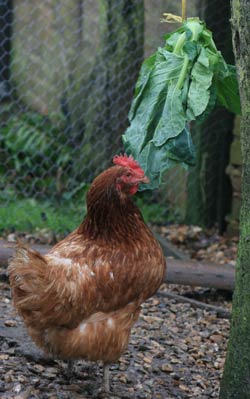 Ample green stuff should be provided for your hens. Grass cuttings, weeds and off-cuts from cabbages, cauliflowers and other greens can be provided at minimal cost. Lettuce should be fed in moderation because it has very little nutritional value (very little Protein and Energy / Calories) and avocado pear is poisonous to hens but most other greens that come from the kitchen will be appreciated by your girls. Try hanging greens in their run, just a little higher than they can reach. As they eat them, they will need to jump to get the last bits so will be getting exercise at the same time as their greens! Win-win!
Ample green stuff should be provided for your hens. Grass cuttings, weeds and off-cuts from cabbages, cauliflowers and other greens can be provided at minimal cost. Lettuce should be fed in moderation because it has very little nutritional value (very little Protein and Energy / Calories) and avocado pear is poisonous to hens but most other greens that come from the kitchen will be appreciated by your girls. Try hanging greens in their run, just a little higher than they can reach. As they eat them, they will need to jump to get the last bits so will be getting exercise at the same time as their greens! Win-win!
If you have an area in which you can grow cabbages in your garden, it may be worthwhile thinking about growing a row for the winter. Cabbages will sit there in the cold, perfectly preserved until picked. You will need to keep them covered with fleece when there are cabbage white butterflies around but don’t worry if they are a little eaten, the chooks won’t mind!
Mealworm treats
Many chicken keepers like to buy mealworms or chicken treats containing these. Chickens love these and are easily tamed by using such tasty treats, however you should keep in mind that animal by-product regulations mean that mealworms are not really allowed to be fed to poultry.

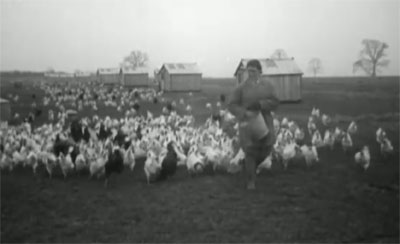

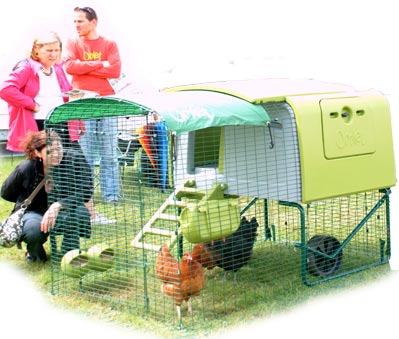


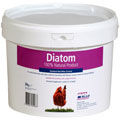
Hi, I have 9 hens 4 are established and laying and 5 we have raised from chicks and are now just comng into lay.
4 established hens, with 2 of them their weight seems to have dropped, one in particular is very scrawney. I feed layers pellets pre-mixed with VermX from Copdock Mill (Suffolk Based) All the hens free range for most of the day in an acre of land. They all still lay with no probs at all and look happy.
The one hen who is very scrawney has also lost some feathers on the back of her neck, they do grow back. She is at the bottom of the pecking order so I wonder if she just doesnt get so much to eat, not sure why she is so thin?
She could be moulting – so is looking scrawny, or, if she really has lost weight (best to weigh her if you can and compare to the others if they are the same breed) then I would suspect worms initially.
Flubenvet will kill all worms – and will at least eliminate this possibility. If you want to use Verm-X, to be sure it is effective, I would use a worm count kit to check for worms. There is an Worm Count Kit offer with Verm-X using a special code on poultrykeeper.
Finally, I would check that she can get to the food without being bullied. The easiest solution to this is to provide more than one feeding place for your hens.
Can I give my chicken’s bread and bird seed?
You can, but only as a treat. Only give less than 10% of their diet.
My girls will not eat layers pellets at all, wet or dry, they’d rather starve.
They do like chick crumb, what could I give them on top of crumb to supplement their diet?
Thanks
Chick crumb is not suitable. It is high in Protein (which will give them the runs) and. Often contains coccicidiostats, drugs which prevent coccidiosis. This should not be fed to laying hens because e drug residue can end up in your eggs.
If your hens are hungry, they should eat dry pellets or layers mash. I haven’t seen a hen yet that doesn’t…
Hi thanks for a brilliant site it has provided so much info for me.
We only got our 3 Welsummers 6 days ago and they are brilliant and have settled in really well. We have an automatic timer for the coop door but my question is this: how soon after the door opens do they need their food to be there? Do I still have to get up at the crack of dawn in the summer to put their feed out, or can it be so many hours later? If so, how much of a lie in can I have before I need to go out? ???
I’m only asking because you advise removing the feeder to avoid rats getting in to the run, although it is made of Weldmesh and has a roof so that it is completely enclosed.
Many thanks.
In the winter, the mornings are dark and I’m sure you’ll be around soon after it gets light but in the summer months, you shouldn’t get problems with rats so much so you could leave their food out.
I only remove food and water if I suspect a rat problem.
The chickens will wait for their food until you get up, but if you’re worried or want to stay in bed until late, I would leave a hopper of food hanging in their house or run.
I’m thinking about getting 6 chicks this year as an amateur egg-enthusiast but I want to raise them as naturally as possible. No commercial grain feed, i.e.: supply them with bugs and worms for the most part. Any suggestions on insects or worm types to buy? Small crickets and meal worms maybe? Also, I know they need essential minerals and vitamins, is there a top quality organic feed I should consider including in their diet or can I make my own? Thanx!
I’m sorry this isn’t something I have experience with. It is hard to formulate your own feeds without being able to test the food for nutrient and vitamin content.